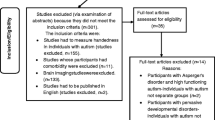Abstract
The present study reports preliminary data from two unselected samples of carefully diagnosed autistic subjects (children and adults) and an assessment procedure that includes a large sample of items, appropriate for lowerfunctioning autistic subjects, with multiple presentations within and between sessions 1 week apart. The study seeks to determine (1) whether a raised incidence of non-right-handedness exists in these samples (2) if so, what constructs best represent this shift in the handedness distribution (i.e., phenotype and CNS substrate) and (3) whether these handedness phenotypes are associated with different levels of cognitive functioning. The results reveal a dramatic shift away from right-handedness in both autistic samples, due to a raised incidence of two phenotypes, manifest left-handedness and ambiguous handedness. The ambiguously handed, who were postulated to represent substantial bilateral CNS pathology due to early brain injury, were found to have much lower intellectual scores in one of the study samples.
Similar content being viewed by others
References
American Psychiatric Association. (1980).Diagnostic and statistical manual of mental disorders (3rd ed.). Washington, D.C.: Author.
Annett, M. (1972). The distribution of manual asymmetry.British Journal of Psychology, 63, 343–358.
Bakan, P. (1977). Left-handedness and birth order revisited.Neuropsychologia, 15, 837–839.
Barry, R. J., & James, A. L. (1978). Handedness in autistics, retardates, and normals of a wide age range.Journal of Autism and Childhood Schizophrenia, 8, 316–323.
Bradshaw-McAnulty, G., Hicks, R. E., & Kinsbourne, M. (1984). Pathological lefthandedness and familial sinistrality in relation to degree of mental retardation.Brain and Cognition, 3, 349–356.
Colby, K. M., & Parkison, C. (1977). Handedness in autistic children.Journal of Autism and Childhood Schizophrenia, 7, 3–9.
Damasio, A. R. (1984). Autism.Archives of Neurology, 41, 481.
DeLong, G. R. (1978). A neuro-psychological interpretation of infantile autism. In M. Rutter & E. Schopler (Eds.),Autism: A reappraisal of concepts and treatment (pp. 207–218). New York: Plenum Press.
Deykin, E. Y., McMahon, P. H., & McMahon, B. (1979). The incidence of seizures among children with autistic symptoms.American Journal of Psychiatry, 136, 1310–1312.
Fein, D., Humes, M., Kaplan, E., Lucci, D., & Waterhouse, L. (1984). The question of left hemisphere dysfunction in infantile autism.Psychological Bulletin, 95, 258–281.
Hardyck, C., & Petrinovich, L. F. (1977). Left-handedness.Psychological Bulletin, 84, 385–404.
Hardyck, C., Petrinovich, L. F., & Goldman, R. D. (1976). Left-handedness and cognitive deficit.Cortex, 12, 266–279.
Hauser, S. L., DeLong, G. R., & Roseman, N. P. (1975). Pneumoencephalographic findings in the infantile autism syndrome: A correlation with temporal lobe disease.Brain, 98, 667–688.
Hier, D. B., LeMay, M., & Rosenberger, P. B. (1978). Autism: Association with reversed cerebral asymmetry.Neurology, 28, 348–349.
Hobel, C. J., Hyvarinen, M. A., Okada, D. M., & Oh, W. (1973). Prenatal and intrapartum high-risk screening. I. Prediction of the high-risk neonate.American Journal of Obstetrics and Gynecology, 117, 1–9.
McCann, B. S. (1981). Hemispheric asymmetries and early infantile autism.Journal of Autism and Developmental Disorders, 11, 401–411.
Prior, M. R., Tress, B., Hoffman, W. L., & Boldt, D. (1984). Computed tomographic study of children with classic autism.Archives of Neurology, 41, 482–484.
Rutter, M. (1971). The description and classification of infantile autism. In D. W. Churchill, G. D. Alpern, & M. K. DeMyer (Eds.),Infantile autism. Springfield, Illinois: Charles C Thomas.
Satz, P. (1972). Pathological left-handedness: An explanatory model.Cortex, 8, 121–137.
Satz, P. (1973). Left-handedness and early brain insults: An explanation.Neuropsychologià, 11, 115–117.
Satz, P., Baymur, L., & Van der Vlugt, H. (1979). Pathological Left-handedness: Cross-cultural tests of a model.Neuropsychologia, 17. 77–81.
Satz, P., Soper, H. V., Orsini, D. L., Henry, R. R., & Zvi, J. C. (1985). Handedness subtypes in autism: Some putative etiological markers.Psychiatric Annals, 15, 447–450.
Silva, D. A., & Satz, P. (1979). Pathological left-handedness: Evaluation of a model.Brain and Language, 7, 8–16.
Soper, H. V., & Satz, P. (1984). Pathological left-handedness and ambiguous handedness: A new explanatory model.Neuropsychologia, 22, 511–515.
Tsai, L. Y. (1982). Handedness in autistic children and their families.Journal of Autism and Developmental Disorders, 12, 421–423.
Tsai, L. Y. (1983). The relationship of handedness to the cognitive language and visuo-spatial skills of autistic patients.British Journal of Psychiatry, 142, 156–162.
Author information
Authors and Affiliations
Additional information
This research was supported, in part, by the following DHS funds: NIH (NS-18462) award to the second author, NIMH Fellowship (1 F32 MH09082) to the first author, and USPHS Fellowship (5 F34 08865) to the fourth author. The authors wish to thank Suzanne McCallum, M. A., and Elizabeth Schmid, M.D., for useful discussions during the course of this research. Special thanks are also extended to Drs. Peter Tanguay (UCLA) and Israel Perel (Camarillo) and their respective staffs for help in facilitating the subject selection. We would also like to thank Dr. B. J. Freeman for supplying the intellectual data. The authors also gratefully acknowledge Susan Benton, Pennie Foster, Geralyn Freeland, Bruce Hersch, Laura Mayo, Frank Wood, Ute Wurfer, and Edie Zusman for their help in data collection. Special thanks are also extended to Mrs. Nita Mize and Mr. James Stonich for assistance in manuscript preparation.
Rights and permissions
About this article
Cite this article
Soper, H.V., Satz, P., Orsini, D.L. et al. Handedness patterns in autism suggest subtypes. J Autism Dev Disord 16, 155–167 (1986). https://doi.org/10.1007/BF01531727
Issue Date:
DOI: https://doi.org/10.1007/BF01531727




